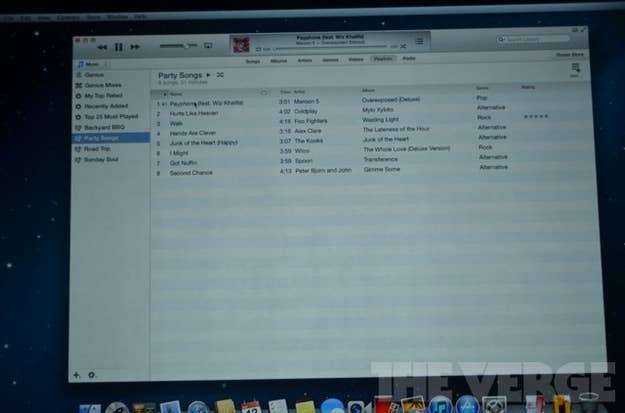
The iPhone 5 launch didn't focus much on music, but there was a lot of it onstage. Mostly it was popular, down-the-middle picks like Adele and Maroon 5. A few minutes into his iTunes talk, Phil Schiller spoke the actual words, "here's some photos Coldplay is sharing."
Apple's very deliberate about the media it features (think of how often Pixar pops up in iPad demos), so it's worth looking at exactly what made the cut:

Feist, Wilco and Spoon were still in evidence, but they were folded in among Al Green's Greatest Hits, Abbey Road and, of course, a closing mini-set from the Foo Fighters. It was an anodyne take on the pop marketplace. No country, no rap, and noticeably less interesting than what you would have seen even five years ago. Apple has a large enough audience that it's stopped worrying about drawing people in, and started worrying about scaring people off.
Apple's at the tail end of a decade-long tango with a certain style of chart-minded indie hit, a cycle that rose in tandem with the iPod. It's some of the most popular music ever categorized as "indie." Feist was the biggest example, dozens of other bands have colonized the niche since then, from Gotye and fun. to Peter, Bjorn & John. Thanks to millions of dollars in marketing, that was the sound of the iPod.
Apple didn't create the niche, but it colonized it so fast that it's hard to imagine the iPod without it. For proof, here's the iPod's first ad, circa 2001, before Apple locked onto the underpop strategy.
It's almost unrecognizable. Where are the silhouette dancers? Where's the inviting minimalism? What the hell is that font? It's strange to remember, but that's what Apple looked like, pre-iPod.
Now look at this:
That's more like it. And that song! By now, everyone's heard it, but before the commercial it was an also-ran from the Swedish Garage Rock scene. It's biggest previous exposure was as background music in SSX 3. Suddenly transforming it into "that iPod song" was great news for Caesars (who by then, were onto the next album), but it was even better for Apple. The ad was giving us this cool thing no one was really into yet — kind of like the iPod! And even though the band was, in a strictly literal sense, a Swedish band nobody had ever heard of, it didn't feel cooler-than-thou or inaccessible. You just hadn't heard of them yet.
It's rare to see a musical trend lining up with a marketing trend so perfectly, but not so rare that it hasn't happened before. Think of Michael Jackson and Pepsi in the late 80s, both broad populist brands trying to broadcast their awesomeness to every last person on earth. When they made ads together, it meant high production values and ridiculous bombast because that was what pop music meant in the late 80s. Also, it was a great way to sell soda.
Starbucks pulled off a similar trick with the acoustic adult contemporary that had been bubbling up in public radio for years. They even made a label out of it, effectively owning the genre of "coffee shop music." Apple's tack was the indie hit that bubbles up into the mainstream. Like Apple itself, it was starting on the outside — cut off from Microsoft, cut off from Clear Channel — and building something so much better that it broke through.
Folded in among the iPhone 5 hubbub were some important iTunes changes. In the next version, the music store will look just like the movie store and the book store, instead of being put on a pedestal as in previous versions. It's the clearest sign yet that Apple doesn't have much interest in the music business, much less the indie hit-making business. Those songs were useful when Apple needed to sell iPods, but these days, they're into bigger and better things. iPods still get a spot on stage because they make so much money, but Apple's heart is with the phone, the tablet. And since the new ads aren't about iPods, they don't have much use for pop music. They traffic in pastoral audio loops and Philip Glass minimalism.
It's the sound of clean design and productivity. Nobody's going to to dance to it.


